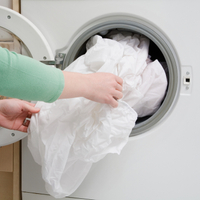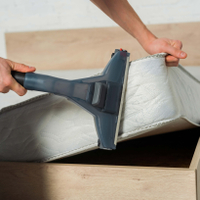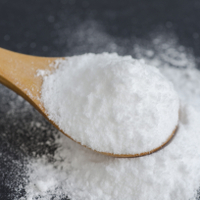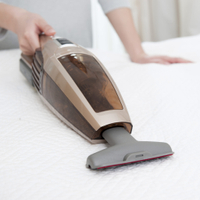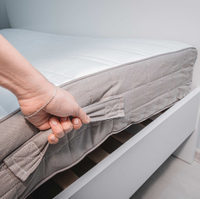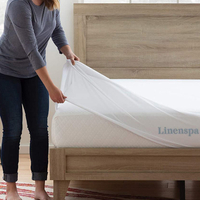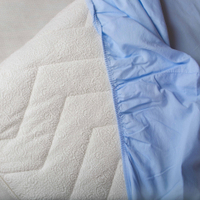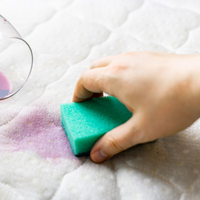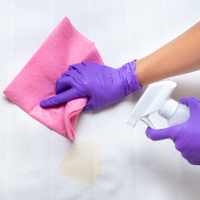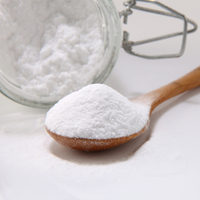Whether you’re looking to do a general clean, or have an urgent spill or stubborn stain to remove, we’ll walk you through how to clean a mattress in this guide. We’ll show you the equipment you’ll need, and explain which technique to use in which situation. (And if it turns out that your mattress is beyond saving, take a look at our best mattress guide for a replacement - there are options for all budgets.) Before you buy, there are some things to consider. Remember to always read the care instructions carefully before cleaning your mattress. Memory foam mattresses should not get wet, for example, so never pour water on them to clean them. All of the techniques here bear this in mind, but it’s still worth searching on the brand’s website for specific care instructions before cleaning your mattress. We recommend buying the best mattress protector you can to reduce allergens, stains and help your mattress last longer. In the meantime, here’s everything you need to know about how to clean a mattress to get rid of dirt and stains. If you’ve ever wondered why has my pillow turned yellow, you should check out how to wash a pillow and how often should you change your bedsheets.
How to fix a squeaky bed - quick tips to stop the noise
How to clean your mattress: deep clean
It’s a good idea to clean your mattress every six months or so, even if you haven’t spilt anything recently. Most people spend seven-plus hours sleeping on their mattress each night, and during that time, dust, dirt and dead skin cells quickly build up - as do dust mites, which eat your dead skin. You’re also likely to get marks from body oil over time, and if you don’t clean your mattress regularly, it may begin to smell too. Luckily, giving your mattress a routine clean is cheap and easy. All you need is a vacuum cleaner (opens in new tab) (with attachments), as well as some common ingredients you’ll likely find in your kitchen or bathroom cabinets. Here’s what you need to do.
How to clean your mattress: recent spills
Your best bet when it comes to dealing with a recent spill is to clean the mattress as soon as the accident occurs (or when you first notice it). Whether it’s coffee or tea in the morning, baby formula spit-up, urine, blood or any other culprit, you have a much better chance of removing the stain from your mattress if you treat it as soon as possible. For most stains, you can follow the process here using a diluted fabric cleaner, mild detergent or natural solution. You can make your own by mixing liquid dishwashing soap or white vinegar with water and adding the mixture into a spray bottle (we cover this process in the steps below). If it’s a biological stain, such as blood, urine or vomit, make sure the solution is enzyme-based - this will break down the proteins in the stain and make it easier to remove. We’ve covered some homemade solutions for those in the stubborn stains section further down the guide - scroll down to the section you need (urine, blood and so on), and then follow this process with the appropriate solution. Alternatively you can buy an off-the-shelf enzyme-based spot cleaner, such as Rocco & Roxie Stain & Odor Eliminator (opens in new tab), and use the method here with that instead. Whichever solution you use, remember that mattresses aren’t meant to get wet - they risk growing mold if they do (particularly memory foam mattresses) - so never pour water on them to clean them. Instead, once you’ve soaked up any excess liquid, you’ll need to spot-clean the spill with a stain remover, ideally applying the solution to a damp cloth rather than directly to the mattress, and gently blotting the affected area. With that in mind, here’s how to clean a mattress after a recent spill.
How to clean your mattress: stubborn stains
If you like to spend a lot of time in your bed - we don’t blame you when are sleeping on one of the best memory foam mattresses - accidents will likely happen. That could be coffee or tea spills in the morning, wine stains when lounging in bed and watching TV, as well as sweat, vomit, urine, and dog or cat urine. Yep, when the party’s in your bed, anything can (and does) happen. As always, the best advice is to treat an accident as soon as it happens. If you’re dealing with a fresh stain, jump up to the recent spills section and follow the process there. But if you’re treating a dried or particularly stubborn stain, you’re in the right place. Read on for how to clean urine, blood and more from a mattress…
How to remove urine stains from a mattress
Whether you have little ones or let pets sleep in your bed, learning how to remove urine from a mattress is a life skill you’re going to want to have. The good news is that it doesn’t have to be complicated or cost a lot of money. However, you’ll need to use a slightly heavier cleaning solution for dried urine than we covered in the recent spills section. Hydrogen peroxide is an oxidizing agent that changes the chemical compound of urine by breaking down the part of the molecule that absorbs visible light and colour. Alternatively, for really stubborn urine stains, use an enzyme-based spot-cleaning product that’s specifically designed to treat human or pet urine, such as Woolite Pet Stain and Odor Remover (opens in new tab). Here’s how to remove dry or stubborn urine stains from a mattress…
- Make a natural cleaning solution Mix eight ounces of hydrogen peroxide, three tablespoons of baking soda, and two-four drops of dish soap or liquid laundry detergent in a bowl. Add the mixture to an empty spray bottle.
- Spritz the urine stain Spray the stain until it’s damp but not soaking. Let the mixture sit long enough until it has dried. A layer of baking soda residue will form after four-six hours.
- Vacuum the mattress When it’s dry, vacuum the dried baking soda from the mattress, making sure you work into any crevices or folds. (Make sure it is dry, otherwise it could damage your vacuum cleaner.)
- Check the mattress If there are any lingering stains or odors, repeat steps one to three. Rinse your bottle out when you’ve finished.
How to remove sweat stains from a mattress
You sweat while you sleep, and over time all that body oil can leave its mark on your beloved mattress. (If your mattress is a few years old and hasn’t been cleaned in a long time, some of those yellow stains could be due to aging, too.) Luckily, there are a number of ways to clean a yellow-stained mattress. In the first instance, try just adding baking soda to the stain - gently rub it in, leave for 15 minutes, and then vacuum. If that doesn’t work, you’ll need a stronger solution. As with the technique we covered for treating urine stains above, this method uses hydrogen peroxide, which is very effective but can bleach some materials, so use it sparingly, and consider testing it on a small area of the mattress before using it on larger stains. Alternatively, use an enzyme-based spot-cleaning product, such as Woolite Pet Stain and Odor Remover (opens in new tab) - again, test it on a small area first. Here’s what to do…
- Create a cleaning solution Mix one cup of hydrogen peroxide with one cup of warm water, and between one quarter and one third of a cup of liquid dish soap. Add the solution to a spray bottle.
- Spray the stain Spritz the stain and let it sit for 20 to 30 minutes. You may need to work the mixture in with a cloth or brush.
- Blot with water This will remove the cleaning solution, being careful not to soak the mattress. Then let the stain air dry. After this assess the area - if any stain remains, repeat steps one to three.
How to remove blood stains from a mattress
There’s a good chance you’re going to have to scrub blood out of a mattress at some point in your life. As with all stains, addressing blood marks as quickly as possible will improve the chances that you’re able to remove it. If the bloodstain is small and hasn’t set, you might be able to use a cold water, vinegar and baking soda solution, as mentioned above, and let it sit for at least 30 minutes. But for tougher blood stains, try the method below. Top tip: never use hot water on blood stains - it effectively cooks the proteins in the blood, locking in the stain. Only use cold water, which will dissolve the blood. If the blood stain is very new, dabbing it with a cold water-soaked cloth may be enough to remove the mark from the mattress.
- Create a meat tenderizer paste Combine one tablespoon of a meat tenderizer powder, such as McCormick Unseasoned Meat Tenderizer (opens in new tab), with two teaspoons of cold water to form a paste in a bowl. The enzymes in the meat tenderizer will break down the proteins in the blood stain when it’s applied.
- Rub it over the blood stain Apply the mixture to the bloodstain on the mattress and let it sit for at least 30 minutes. This gives the paste time to break down the proteins.
- Work at the stain Now use a toothbrush and bowl of clean, cold water to scrub the stain until it’s gone. When you’re happy, blot the area with a clean cloth to remove any excess cleaner. If the stain is larger, you could use a bigger brush or vacuum the residue away instead.
How to remove coffee, tea and wine from a mattress
To remove non-biological stains such as coffee, tea or red wine (or any other food or beverage accidents), you can undo a lot of the initial damage by blotting the spillage away as soon as it occurs, dabbing cold water on the area and sprinkling a generous layer of salt over it to absorb the liquid. After a few minutes, gently rub the salt into the stain (don’t scrub), and then blot dry with a clean cloth, and vacuum the mattress. Alternatively, baking soda works with this method too. However, to remove older or tougher food or drink stains, try the following method.
- Mix a non-chemical solution Combine one part laundry detergent, one part vinegar, and 10 parts water in a spray bottle.
- Spray the stain Mist the stain (don’t soak it) and brush the area very gently with an old toothbrush. Then allow it to sit for 10-15 minutes.
- Blot gently Blot the stain with a damp sponge or towel; then blot with a dry towel or cloth to remove any excess liquid. Inspect the mattress and repeat steps two to three as necessary.
How to clean your mattress: remove odors and oils
The kitchen staple baking soda will be your friend when it comes to removing odors from your mattress. Corn starch is another tool that will absorb body oil, which could be another reason why your mattress smells.
- Deodorize with baking soda The simplest way to deodorize a mattress is to sprinkle baking soda over it and let the powder sit for at least 30 minutes - preferably for a few hours - before vacuuming the mattress with a (clean) upholstery attachment.
- Remove body oils with corn starch Attack body oils by mixing a few tablespoons of corn starch, such as Clabber Girl (opens in new tab), with one cup of baking soda before sprinkling it on the mattress. You could also add five to 10 drops of a favorite essential oil, such as Artizen Essential Oils (opens in new tab), to the mixture before shaking it on your bed for a pleasing scent that should last a few days.
How to clean your mattress: dust mites
Dust mites are microscopic pests that feed on the dead human skin cells found in dust. They’re not parasites, but their feces contains allergens that can make you sneeze and causes breathing troubles for those with asthma. Dust mites thrive in mattresses, bedding, upholstered furniture and carpets, and prefer warm, humid environments. No matter how clean your home is, they can’t be totally eradicated - but you can reduce them, and you don’t need professional help. The best way to reduce dust mites is to clean your mattress, bedding and bedroom regularly. Wash all sheets, blankets, pillowcases and bedcovers in hot water set to at least 130 degrees Fahrenheit (54 C) to kill dust mites and remove allergens. Make sure you use the highest setting on the dryer as well. It’s also a good idea to use a mattress protector (opens in new tab) to limit exposure to dust mite feces. In addition, you could invest in a dehumidifier (we’ve curated the best dehumidifiers (opens in new tab) elsewhere on the site) and keep the humidity at less than 50 per cent to prevent dust mites from multiplying.
How to clean your mattress: bed bugs
If you suspect you have bed bugs, we suggest seeking professional help from a bed bug extermination company to get rid of them and the eggs they left in your home. Bed bug removal is a serious undertaking and you’re going to want to make sure you get rid of them once and for all. Here’s a more thorough look into how to get rid of bed bugs.
How to clean your mattress without a vacuum
If you don’t have a working vacuum cleaner, fear not. You don’t need to vacuum your mattress in order to get it clean. The spot treatment method for sweat stains, above, will address yellowing, for example. You can also use a steam cleaner to kill dust mites and bacteria - just make sure it gets to at least 200 degrees Fahrenheit. Steam cleaners can be bought online, or rented from a company like Lowe’s (opens in new tab) or Home Depot (opens in new tab) if you don’t want to store it. 2. Strip your bed Throw all bedding in the laundry, and use an everyday odor-fighting detergent to clean it, such as Arm & Hammer Plus OxiClean Odor Blasters Fresh Burst (opens in new tab). 3. Address any stains, either using a natural solution… Mix one cup of hydrogen peroxide with one cup of warm water, and between one quarter and one third of liquid dish soap. Add the solution to a spray bottle. Spritz the stain and let it sit for 20 to 30 minutes. Then blot with water and let the mattress air dry. 4. …or by using a steam cleaner Follow the directions on the steam cleaning machine for how to use it. 5. Allow the mattress to dry for at least four hours Open a window or point a fan towards the bed to speed up the drying process.
How to clean your mattress professionally
Sometimes it’s just easier to get the professionals in. To have your mattress cleaned professionally, search for a professional mattress cleaning company in your area, looking for good reviews and recommendations from customers. Most companies will only clean spring mattresses and not memory foam mattresses, since those should not get wet. The cost of the mattress cleaning service will depend on the size of your mattress, where you live, and the company. However, as a benchmark you can expect to pay between $75 and $200 for a professional mattress cleaning service. Here’s what the process for booking a professional mattress cleaner might involve, plus some tips and tricks for getting the most out of the service:
If you can, schedule an appointment for earlier in the day since it might take eight hours for the mattress to dry.Remove bedding and pillows before the professionals arrive.Clear an area around the bed so technicians can maneuver about the room.The professional will inspect the mattress and foundation, noting stains to address alongside the general clean.Usually a professional cleaning involves vacuuming, spot treatment of stains, followed by steam cleaning or dry-steam cleaning. Some companies use additional techniques like UV light or infrared heat services to kill dust mites.
How to keep your mattress clean for longer: tips
We’ve covered how to clean your mattress in depth in this guide, but the real trick is to keep your mattress clean on a day-to-day basis. This will help it last beyond its warranty, and ensure it looks and smells as good as possible for the next few years. The following tips will help you take care of your mattress, and keep it in a good condition for longer.
Always address fresh stains right away.Launder bedding in hot water weekly.Inspect your mattress and foundation often. Look for signs of bed bugs as well as aging stains, spots or problems.Vacuum your mattress at least twice a year during a deep clean.Flip your mattress every six months or rotate it 180 degrees to prevent indents.Always use a mattress protector to minimize exposure to dust mites and to help prevent spills and accidents from becoming mattress stains.Note any rips, sagging, lumps or problems and address them with the manufacturer as soon as you see them. Your mattress may be under warranty and available for replacement; or, some companies might send out a representative to take a look.
Does Goodwill take mattresses? Everything you need to knowHere’s how to get rid of fruit flies fastWant to know how to wash a pillow? Check out how to clean a microwave
If you’re dealing with a fresh spill, or an older or tougher stain, there are plenty of natural solutions you can make to clean a mattress using typical household ingredients - baking soda, white vinegar and water - and you can also add hydrogen peroxide for a stronger solution. We’ve covered the best techniques in the recent spills and stubborn stains sections. However, if your mattress is prone to accidents - say, if you have a young child or pet - it’s a good idea to buy an off-the-shelf enzyme-powered spot cleaner to keep in your cupboards. Caring for your mattress regularly will help prevent yellow stains. Clean it twice a year according to the steps above, always use a mattress protector to reduce dust, allergens and stains from impacting the mattress, and wash your sheets regularly. You could add a soothing scent to your mattress by putting scented dryer sheets (Snuggle Exhilarations lavender and vanilla scent (opens in new tab), for instance) under the mattress protector and replacing them weekly when you launder your bedding.
